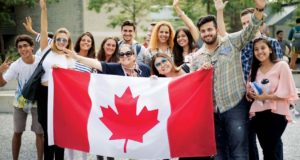Indians Immigrate To Canada In Record Numbers
Ottawa: The number of Indians immigrating to Canada has more than quadrupled since 2013. A new report finds many Indian students have decided to attend Canadian universities rather than U.S. universities because Canada’s immigration policies are better at attracting and retaining talent. The data show Canada’s policies have translated into more Indians immigrating to Canada.
Diplomatic issues between India and Canada that have affected visa processing and a two-year Canadian cap on international student permits will reduce the number of Indians obtaining student visas to attend Canadian universities in the short term. Absent changes in U.S. immigration policies, those developments may not affect the choices of Indians in the long term.
“Highly skilled foreign nationals, including international students, have been choosing Canada over America because it is difficult to gain H-1B status or permanent residence in the United States, and easy to work in temporary status and acquire permanent residence in Canada,” according to a National Foundation for American Policy analysis. “More favorable immigration policies are a significant factor in Canada attracting international students, particularly students from India.”
The NFAP analysis notes that Canada has no annual limit on high-skilled temporary visas. Most Canadian visas for high-skilled foreign nationals are processed within two weeks. In the United States, gaining H-1B temporary status after graduating from a university has grown more difficult, with the H-1B annual limit reached for more than 20 consecutive fiscal years.
Problems for high-skilled foreign nationals continue after gaining H-1B status. A professional from India could wait decades for permanent residence due to the per-country limit and low annual limit on employment-based green cards. Over 1.2 million Indians, including dependents, are waiting in the first, second and third employment-based green card categories, according to an NFAP analysis.
The story is much different in Canada. Some provinces have programs with numerical limits that allow individuals with a master’s or Ph.D. from Canadian universities to gain permanent residence even without work experience, according to Peter Rekai, an attorney with Rekai LLP in Toronto. Sen. Charles Grassley (R-IA) blocked including an exemption from green card limits for many international graduate students in science and technology fields during negotiations over the 2022 CHIPS and Science Act.
By signing up, you agree to our Terms of Service, and you acknowledge our Privacy Statement. Forbes is protected by reCAPTCHA, and the Google Privacy Policy and Terms of Service apply. “In Canada we have a program for graduating international students similar to but more generous than the U.S. Optional Practical Training category,” said Rekai. He notes that while working on a three-year post-graduation work permit, a student who works for one year or more in a high-skilled position will likely gain the necessary points under Canada’s Express Entry system to receive permanent residence.
In July 2023, Canada’s program to entice H-1B visa holders to the country attracted so many applications that it reached the 10,000 limit in less than 48 hours. “Between 2013 and 2023, Indians immigrating to Canada rose from 32,828 to 139,715, an increase of 326%,” according to the NFAP analysis.
Indian enrollment at Canadian universities rose more than 5,800% in the last two decades, from 2,181 in 2000 to 128,928 in 2021, an increase of 126,747 students. Between 2016 and 2019, Indian international students enrolled in U.S. universities dropped by 13% but increased by 182% at Canadian universities. Diplomatic issues between India and Canada have reduced Indian student visa approvals in the short term.
International student enrollment at Canadian universities rose from 62,223 in 2000 to 400,521 in 2021, increasing by 544%, according to the NFAP analysis. International student enrollment in America increased by 45% between 2000 and 2021.
The Trump administration made it more challenging to obtain H-1B status and signaled it might restrict or eliminate Optional Practical Training for students. Analysts say those policies likely scared off many international students.
Between 2016 and 2019, international student enrollment fell by almost 6% at U.S. universities but rose nearly 52% at Canadian universities. Although Canada recently placed a two-year limit on new international student permits, the government exempted students in master’s degree and Ph.D. programs. The Canadian government will lengthen the validity of many post-graduation work permits for graduate school programs.
International student enrollment at U.S. schools, including among Indians, regained lost ground in the 2022-23 academic year. Some of the gains could be due to the end of the Covid-19 pandemic (i.e., students who did not enroll in 2020 or 2021). The enrollment of Indian students in 2021-22 was similar to 2016-17 but soared in 2022-2023 at U.S. universities. The end of the Trump administration’s policies may also have contributed to the increased international student enrollment. However, additional years of data may be needed to provide a complete picture.
U.S. educators and employers should note that Chinese students are not coming to the United States as in the past. The NFAP analysis found, “The level of Chinese international students in U.S. graduate-level engineering programs was flat between fall 2016 and fall 2019 and, unlike Indians, declined in 2022.” Chinese graduate students in computer science fell between 2019 and 2022.
“U.S. immigration law remains less attractive than Canada’s for international students who wish to work after graduation,” concluded the NFAP analysis. “That has affected the choices of international students. The gap between the United States and other countries in attracting international students could grow larger if U.S. immigration policy becomes more restrictive.”
Comments





 BJP leader, 2 others booked for farmer’s death
BJP leader, 2 others booked for farmer’s death Now limit replies only to verified users to avoid spam: Elon Musk
Now limit replies only to verified users to avoid spam: Elon Musk 3 Pakistani sexually assault college student, videotape; arrested
3 Pakistani sexually assault college student, videotape; arrested ED recovers huge amount of cash linked to Virendra Ram case in Jharkhand
ED recovers huge amount of cash linked to Virendra Ram case in Jharkhand Canada ‘rule-of-law country’: Justin Trudeau on arrest of 3 in Nijjar case
Canada ‘rule-of-law country’: Justin Trudeau on arrest of 3 in Nijjar case Man killed, buried under temple’s ‘havan kund’ in Punjab’s Sangrur, 2 held
Man killed, buried under temple’s ‘havan kund’ in Punjab’s Sangrur, 2 held Afghan diplomat resigns of her interception at Mumbai airport for gold smuggling
Afghan diplomat resigns of her interception at Mumbai airport for gold smuggling 3 Punjabi youth held in Canada for Khalistani activist Hardeep Nijjar’s killing
3 Punjabi youth held in Canada for Khalistani activist Hardeep Nijjar’s killing Indian couple, 3-month-old grandchild among 4 killed in accident during police chase in Canada
Indian couple, 3-month-old grandchild among 4 killed in accident during police chase in Canada SC stays High Court order to reopen road in front of Punjab CM’s residence to public
SC stays High Court order to reopen road in front of Punjab CM’s residence to public Helicopter on its way to pick Shiv Sena leader crashes in Maharashtra’s
Helicopter on its way to pick Shiv Sena leader crashes in Maharashtra’s Election Commission appoints 15 expenditure observers in Punjab
Election Commission appoints 15 expenditure observers in Punjab
 BJP leader, 2 others booked for farmer’s death
May 6, 2024
BJP leader, 2 others booked for farmer’s death
May 6, 2024
 Now limit replies only to verified users to avoid spam: Elon Musk
May 6, 2024
Now limit replies only to verified users to avoid spam: Elon Musk
May 6, 2024
 3 Pakistani sexually assault college student, videotape; arrested
May 6, 2024
3 Pakistani sexually assault college student, videotape; arrested
May 6, 2024














